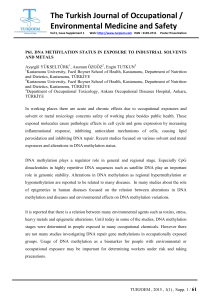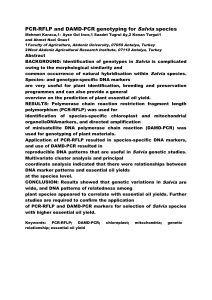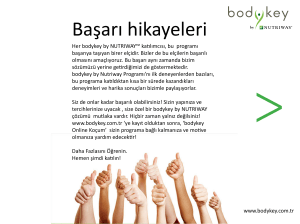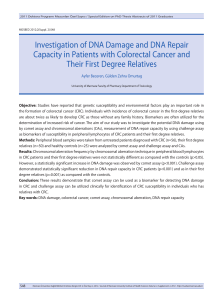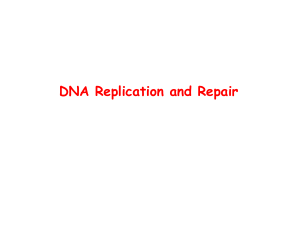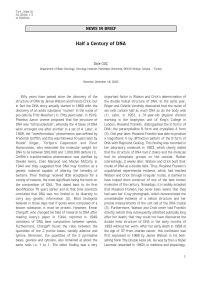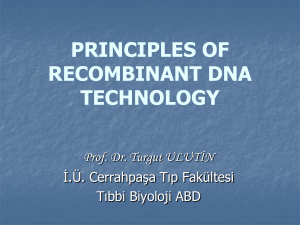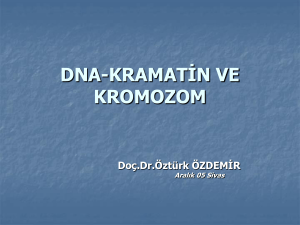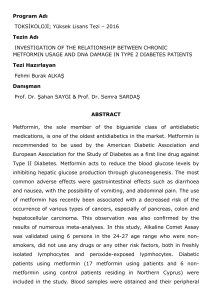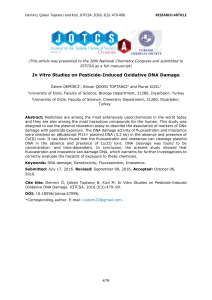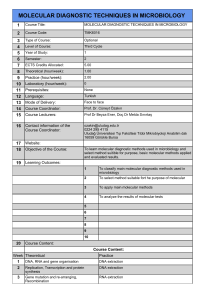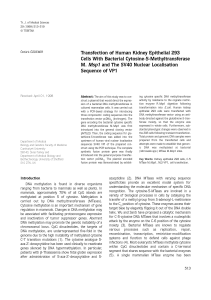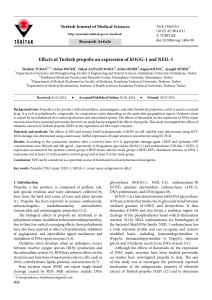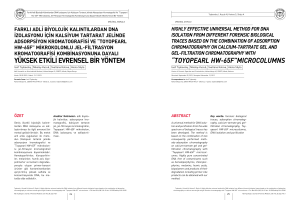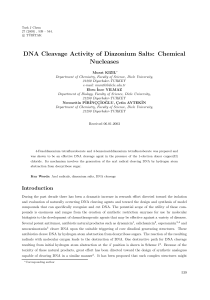KAN GRUPLARININ MOLEKÜLER YAPISI
advertisement
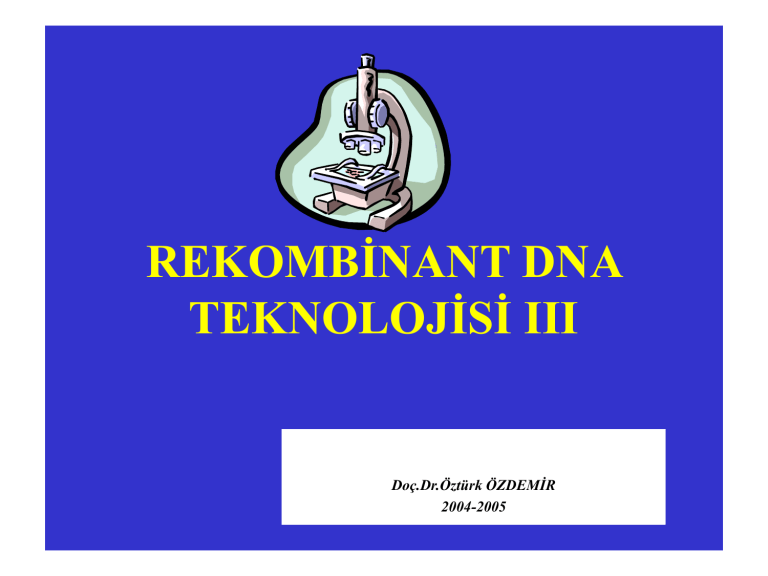
REKOMBİNANT DNA TEKNOLOJİSİ III Doç.Dr.Öztürk ÖZDEMİR 2004-2005 The Tools of Molecular Biology REKOMBİNASYON Rekombinasyon: Yenibileşim - yenidenoluşum. Bir molekülün-hücrenin, atasal “wild type” yada ilkin(orijinal) yapısından farklılık göstermesi durumudur. I - In vivo rekombinasyon II- In vitro rekombinasyon Klon (Clone); Bir tek atasal diploid hücreden mitoz bölünme yoluyla birden fazla hücre eldesine denir. Rekombinant DNA teknolojisi ile sentezlenen identik DNA/gen kopyalarına denir. ”Gene cloning” Genetik Klonlamada Tarihçe Gelişme Araştırıcı Yıl Deniz hayvanlarında döllenme O.Hertwig 1875 İlk kez anne rahmi dışında döllenme L.Schenk 1878 Tüp ortamında insan yumurta hücresi döllendi MF Menkin 1944 Dondurulmuş sperm ile inek yumurtası döllendi 1952 Deney tüpünde döllenen bir memeli yavru doğdu 1959 Dondurulmuş embriyodan yavru fareler elde edildi 1972 Louise Brown isimli bebek deney tüpünde döllendi anne rahmine yerleştirilerek sağlıklı doğum yaptırıldı 1978 Avusturalyada donmuş embriyodan sağlıklı bir kız çocuğu elde edildi 1984 Genetik Klonlamada Tarihçe Gelişme Yıl Kiralık anne Mary Beth bebeğini vermeyi redetti. 1986 Embriyo hücrelerinin çoğaltılmasıyla çok sayıda kuzu elde edildi 1987 İnsan embriyosu klonlandı çok tepki aldı J.Hall Dolly klonlandı 1993 I.Wilmut 1997 Fransada bir dananın 63 klonu elde edildi Totipotent stem hücrelerinden deneysel organogenezis Farede gen klonlama yöntemiyle insan kulağı gelişimi sağlandı Avusturalyada bir at klonlama ile Coada eşek doğurdu 1999 2000 2001 2002 Amerikada ex vivo yapay rahim geliştirildi 2002 Klonlama Tipleri DNA /Gen düzeyinde klonlama Hücre düzeyinde klonlama Organizma /çekirdek düzeyinde klonlama Başarılı Klonlama Yapabilmek İçin Gen; Bağımsız olarak replike olabilmeli Konak hücreye kolaylıkla transfer edilebilmeli Seleksiyona olanak tanımalı Memeli Hücrelerine Gen Transfer Teknikleri Microinjection*** DAAE-Dextran Mediated Electroporation Lipofection Calcium Phosphate*** Protoplast Fusion Polyprene Viral infection*** (Lentivirus, Retrovirus, Adenovirus) *: Yaygın kullanılan yöntemler Genetik Klonlamada Kullanılan Vektörler Plazmid Bakteriyofaj Cosmid YAC Baculovirus BAC PAC Lentivirus ** 5-10 kb 20 kb 50 kb 100 kb 150 kb 200 kb 250-300 kb ~ 100-200 kb The construction of Mammalian Transfection Vector For Expression of Cytosine- 5 Specific DNA Methyltransferase Gene M.Msp1 In Cultured Cells Ozturk OZDEMIR Received 01.05.1997 STOPLAZMİK KALITIM (YUMURTA HÜCRESİ) • Regülatör - modülatör proteinler • Yumurta polarity genler • Segmentasyondan sorumlu genler (25 adet) • Yumurta hücresindeAnterioposterior gradiyent farkı • Remodelling faktörler ; • • • • • zigotik effect integrinler transkripsiyon faktörleri pair-rule genler segment polarity genler • Homeodomeik, Hox (Homeobox) fetusa ait genler Nükleer Transplantasyon • Wilmut ve arkadaşları donör hücre olarak 6 yaşında sağlıklı bir koyunun meme epitel hücresi ve resipient hücre olarak ise aynı koyunun metafaz II evresinde bekletilmiş enucleated yumurta hücresi kullandılar. Klonlama sonrası elde edilen ve annesiyle %100 aynı genotip ve fenotipte olan sağlıklı kuzuya DOLLY adını verdiler. DOLLY Doç.Dr.Öztürk ÖZDEMİR Nükleer Klonlamanın Önemi Yumurta hücresinin embriyogeneziste spermden farklı artı(+) öneminin olduğu, Ökaryotik hücrenin G0 evresinde totipotent kromatin organizasyonu kazandıği, Metafaz II evresinde yumurta hücresinin klonlama için en uygun stage olduğu, Memelilerde eşeysiz üremenin mümkün olduğu, Bir gen yerine çekirdeğin tamamının transplante olabileceği gösterildi Klonlama Sonrasında; Unipotent hücrenin totipotent hücreye dönüştürülmesi, Sinir hücrelerinin rejenerasyonu, Telomerlerde ” end replicatin problem”giderilerek, yaşlanmanın geciktirilmesi, Stem hücrelerinden spesifik doku eldesi, Epigenetik modifikasyonu ile kanser tedavisine yeni bir yaklaşım, “Ex vivo gene replacement” ile genetik tedavi ve İnsan genom projesi önemli bir ivme kazanmıştır. Goals of DNA Technology 1. Isolation of a particular gene or sequence 2. Production of large quantities of a gene product 1. Protein or RNA 3. Increased production efficiency for commercially made enzymes and drugs 4. Modification/improvement of existing organisms 5. Correction of genetic defects Amplifying DNA Often we need large quantities of a particular DNA molecule or fragment for analysis. Two ways to do this:- 1. Insert DNA mol. in a plasmid and let it replicate in host >>> many identical copies (= ‘DNA cloning’) 2. Use PCR technique - automated multiple rounds of replication >>> many identical copies. DNA Cloning 1. Purpose:- to amplify (bulk up) a small amount of DNA by inserting it into in a fast growing cell e.g. bacterium, so as bacterium divides we will have many copies of our DNA 2. 1. Obtain a DNA vector which can replicate inside a bacterial cell (plasmid or virus) which 3. 2. Insert DNA into vector - use restriction enzyme 3. 3. Transform host cells i.e. insert vector into host cell (e.g. bacterium) 4. 4. Clone host cells (along with desired DNA) 5. 5. Identify clones carrying DNA of interest Vectors are convenient carriers of DNA. They are often viruses or plasmids. Usually are small circular DNA molecules and must be capable of replicating in the host cell The DNA of interest must be inserted into the vector. Restriction Enzymes Target or recognition sequence Restriction enzymes (R.E.) recognise target sequences and cut DNA in a specific manner. Cuts here This R.E. leaves TTAA single stranded ends (‘sticky ends’) If you cut DNA of interest and plasmid with same restriction enzyme then you will have fragments with identical sticky ends. Sticky ends will readily rejoin - so its possible to join 2 DNA’s from different sources AATT TTAA Plasmids are usually chosen to have only one target site. DNA of interest can then insert into this site Recombinant plasmid Transformation of host and selection of desired clones • Bacteria are made to take up the recombinant plasmid & grown (cloned) in large numbers (TRANSFORMATION) • Bacteria carrying desired sequence can be selected. • Large amounts of DNA or proteins can be extracted work with gene work with protein Making a Genomic Library Genomic library = a complete collection of DNA fragments representing an organism’s entire genome. 1. Cut up genome into thousands of fragments with an R.E. 2. Insert each of these into separate plasmids and then into separate host cells. 3. Result - a collection of bacterial colonies (clones) carrying all the foreign DNA fragments i.e. a genomic library A question for you - how will a cDNA library differ from a genomic library ? • Which would have more genes ? • What would be present in the clones in each case? – – – – Promoters ? Enhancers Introns ? Poly-T (from poly-A tail)? How do we identify DNA mols. of different sizes ? long short DNA DNA Gel Electrophoresis Standards of known M.W. Run DNA fragments through a gel under influence of an electric current. Each of the DNA fragments travels through the gel at a constant speed appropriate for its size. Longer molecules move more slowly so don’t travel as far. See Fig 20.8 Polymerase Chain Reaction (PCR) Small amount of DNA can be amplified greatly automated process involves:• A DNA polymerase which is stable at high temperatures • specific primers to start off replication at known position. • Three step cycle: 1. Heat to separate DNA strands = Denaturation 2. Cool and allow primers to bind (Annealing) 3. Polymerize new DNA strands (Extension) Repeat steps 25 – 35 times >>> millions of copies of original DNA Polymerase chain reaction Denaturation (95C) Primer annealing (50C) 15 Polymerase chain reaction Extension (72C) Polymerase chain reaction Denature 13 Polymerase chain reaction Denature Anneal primers Polymerase chain reaction Denature Anneal primers Extend Polymerase chain reaction Denature Polymerase chain reaction Denature Anneal primers Polymerase chain reaction Denature Anneal primers Extend Extend Anneal primers Denature Polymerase chain reaction Bacterial Plasmids • Plasmids are small, circular DNA molecules in bacteria. • By inserting genes into plasmids, scientists can combine eukaryotic and prokaryotic DNA. (Recombinant DNA) • Bacterial cells continually replicate the foreign gene along with their DNA. • Cloning using plasmids can be used to: – Identify a particular protein a gene makes (ie: for study) – Produce large amounts of a particular protein/gene (ie: for use in medicine) Restriction Enzymes • Also used to make recombinant DNA. • Specifically cut DNA molecules at precise base locations. (restriction) Making Recombinant DNA (Fig 20.3) Making Recombinant DNA (Fig 20.3) …Still Making Recombinant DNA …Almost Recombinant Why Use Bacteria as vectors? 1. Plasmids are easy to use to manipulate which genes are expressed in clones. 2. Bacteria replicate very quickly and allow you to produce a large number of a desired gene. Identifying Clones • Not all of the reproduced bacteria are clones carrying the desired gene. • Two ways to identify which are clones: – Look for the gene – Look for the protein the gene codes for Nucleic Acid Hybridization • If you know the sequence of the cloned gene you are looking for, you can make a nucleic acid probe with a complementary sequence. • The probe is radioactively labeled and allowed to base pair with the denatured (separated strands) DNA. • The probes H-bond with their complement (cloned gene), thus identifying the cloned cells. • Identified cells are cultured to produce more. Figure 20.4 Using a nucleic acid probe to identify a cloned gene Expressing Euk. Proteins in Bacteria • It is more difficult to get the bacteria to translate the proteins because of differences in promotor sequences b/t prokaryotes and eukaryotes. • Expression vectors are plasmids that contain the promotor sequence just before the restriction site. • This allows the insertion of a eukaryotic gene right next to the prokaryotic promotor. Expressing Euk. Proteins in Bacteria • Bacteria also lack the enzymes needed to remove introns from DNA. • Therefore, cDNA (no introns) is inserted into plasmids to allow expression of the eukaryotic gene. • Reverse transcriptase is the enzyme used to make cDNA from a fully processed mRNA strand. Figure 20.5 Making complementary DNA (cDNA) for a eukaryotic gene Another Solution: Use Yeast (eukaryotic) • Why? – They grow quickly like bacteria – They are eukaryotes (similar enzymes, metabolic mechanisms, protein mods) – They have plasmids (rare for eukaryotes) – Can replicate artificial chromosomes as well as DNA in plasmids Genomic Libraries • Plasmids and phages used to store copies of specific genes. Polymerase Chain Reaction (PCR) PCR • Faster and more specific method for amplifying short DNA sequences • After DNA is denatured (split), primers start new complementary strands with each strand producing more molecules of the sequence. • In vitro = doesn’t require living cells – In test tube: denatured DNA, free nucleotides, DNA primers (specific to gene desired), “special” DNA polymerase (can withstand high heat w/o denaturing) Analyzing DNA • Gel electrophoresis separates molecules based on size, charge, density, etc. • Linear DNA – mainly separated by fragment length (size) • Molecules of DNA are separated into bands of molecules of the same length. Gel Electrophoresis Restriction Fragment Analysis Southern Blotting Southern Blotting 1. Produce restriction fragments of DNA (restriction enzyme used) 2. Separate fragments (gel electrophoresis) 3. Blotting Transfer DNA to nitrocellulose paper Hybridize with radioactive probes Autoradiography to identify which have probes. RFLPs • Polymorphisms that result from differences in noncoding regions of DNA. • Restriction enzymes cut DNA into different fragments in each variant. • RFLP markers allowed scientists to more accurately map the human genome. • Genetic studies do not have to rely on phenotypic (appearance/proteins) differences to guide them anymore. In Situ (on a slide) Hybridization • Radioactively (or fluorescently) labeled probes base pair with complementary denatured DNA on a microscope slide. • Autoradiography and staining identify the location of the bound probe. Human Genome Project • Attempt to map the genes on every human chromosome as well as noncoding information. • Three stages – Genetic Mapping (linkage) – Physical Mapping – Gene (DNA) Sequencing • Genomes of species that give insight to human codes are also being done (fruit fly, E coli, yeast) Genetic Mapping • Linkage maps based on recombination frequencies created. • Linkage maps portray gene sequences as you physically move along a chromosome. • Genetic markers along the chromosome allow researchers to use them as reference points while studying other genes. Physical Mapping • Determines the actual distance between the markers along a chromosome (# of bases) • Utilizes chromosome walking to identify the distance between. – Use a series of probes to identify the DNA sequence of various restriction fragments, and ultimately the entire length of DNA sample. Chromosome Walking DNA Sequencing • As of 1998, 3% of the human genome had been sequenced using automation. (Sanger Method) • Once the sequences of all the genes are known, scientists can begin to study all of their functions, and manipulate their products in many ways. Applied Genetics • Diagnosis of Genetic Disorders – Sequence individuals before birth to know if their DNA contains abnormalities • Human Gene Therapy – Replace missing or fix damaged genes in affected individuals Gene Therapy Pharmaceuticals • Hormone production (ie: Human Growth) • Protein supplements – HIV treatment: “decoy” receptor protein used to inhibit HIV virus’ ability to enter cell • Vaccines – Proteins that stimulate immune response can be used instead of traditional vaccines • Antisense Nucleic Acids – Block translation of certain proteins Other Uses of DNA Tech • DNA Fingerprinting for forensic cases • Environmental cleanup • Agriculture – Animal Husbandry – Genetic Engineering of Plants The Future of Genetics • The future of science lies in genetics??? Microarrays Microarrays • See Fig. 20.14 • All known genes are spotted on a small solid support (chip). Many uses e.g. • A specific cDNA is tagged with a fluorescent marker and hybridized to the array Microarrays • The cDNAs would bind only to those genomic clones that have complementary DNA sequences • These clones would “light up” Have been used for example to look at cancer cells - which genes are turned ON or OFF compared to normal cells ? DNA Sequencing Uses dideoxy nucleotides to terminate replication of a chain at a known base. Automatic sequencing of DNA Chain termination by dideoxynucleotides Normal nucleotides Dideoxy nucleotide New nucleotide can NOT be added on to this 3’ end New nucleotide can be added on to this 3’ end Dideoxy sequencing All essential components of DNA synthesis are required, namely... DNA polymerase …plus ddNTPs 5 Dideoxy sequencing Can’t extend any more Dideoxy sequencing Result - a series of DNA fragments each 1 base longer than the next and terminating in a specific ddbase e.g ddT or ddG This ddbase is the complementary one to the one on the strand being sequenced e.g ddT would be opposite A Dideoxy sequencing Heat the mixture to separate the dd-terminated strands from the templates Dideoxy sequencing • ddRibo-terminated, - fluorescent DNAs are separated by size using gel electrophoresis • Bases color coded - easy to read sequence. • Sequence here is (from bottom) CCTAGGAATCC + 1 DNA Sequencer machines read the fluorescence of each band - store the sequence in computers Vast amounts of data sequences now on computer accessible by online data banks. Already many complete genomes sequenced. Genome Sizes and Numbers of Genes Organism Genome Size Estimated Number of Genes H. influenzae (bacterium) 1.8 Mb 1,700 S. cerevisiae (yeast) 12 Mb 6,000 C. elegans (nematode) 97 Mb 19,000 A. thaliana (plant) 100 Mb 25,000 D. melanogaster (fruit fly) 180 Mb 13,000 H. sapiens (human) 3,200 Mb 30,000 – 40,000 Southern Blotting • Used to check for the presence of a specific DNA sequence in a mixture of DNA fragments. 1. Separate the mix of DNA fragments by electrophoresis 2. Add a labeled DNA probe. It will attach to a complementary sequence (if present) DNA probe 3. The label will make this band ‘light up’ Northern and Western blotting • Southern blots identify a specific DNA sequence in a mix of DNAs In a similar way:• Northern blots identify a specific RNA sequence in a mix of RNAs • Western blots identify a specific protein sequence in a mix of proteins In-situ hybridization In situ hybridization probes can bind to specific sequences on a chromosome in a cell prep. - show where it is located






